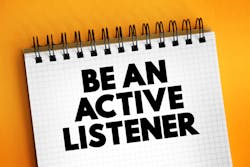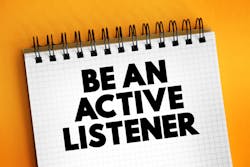Here are the top ten ways service techs and salespeople can gain credibility:
1. Put their mind at ease regarding their immediate problems within the first two minutes. Address the situation or need that prompted the service call first. Then you’re their hero and their mind will be relaxed and open to what else you have to say. Don’t walk in the door and start selling service agreements or bringing up additional products or services until you’ve put their mind at ease regarding their original complaint.
Develop a calming, comforting, and reassuring tone of voice when explaining the problem, when it can be repaired, and the price to do so.
2. Check everything over. The more stuff you look at, the more things you’ll find that require attention. You’ll quote more work on every call, and the more you quote, the more you’ll sell. The more you sell on every call, the more profitable you’ll become.
3. Be an “active listener.” Customers want to be listened to and won’t know you're listening unless you acknowledge what they’ve said, and demonstrate that you’ve- Standing and listening, without doing anything else, while they’re talking
- Repeating back to them what they’ve just said to you (even if it was erroneous or insane).
Ideally, service techs should base their personal appearance decisions on what will appeal to the widest variety of people possible. This includes the proper footwear, headgear, belt buckle and undershirt. This also includes your tools. If you’re selling “quality,” you better not be using cheap tools.
6. Be organized. This pertains to everything from yourFrom the moment you greet the customer, it must be obvious that you are:
- A professional
- Successful at what you do
- Have done this before and have a standard procedure that you follow in this type of situation
- Competent enough to be trusted to take this job and get it done without being watched.
They want you to be able to reach behind you into your tool pouch and, without looking, pull out the right tool and replace it when you’re done. They don’t want to see things thrown about randomly in your truck.
Don’t spread things around in a haphazard fashion, talk to yourself, or make grunting or “struggling” noises while working on the equipment.
Carry a small mat with you and lay your tools and parts on it while you work.
Leave the work area as clean as you found it.
7. Get the customer involved. It’s okay for the customer to leave you alone while you’re doing your diagnostic procedure. In8. Speak in simple terms. Don’t try to impress your customers with your intelligence by using a lot of big words. A confused mind always says “no.” Keep your explanations short, simple and to the point.
9. Do the whole job on the first visit. For many techs, the focus is on running the maximum number of calls per day. This means often deliberately ignoring repairs or procedures that would benefit the customer, but are non-essential. This type of “tunnel vision” approach can cause callbacks, and one callback can suck the profits out of an entire day’s work.
Doing everything that needs to be done while you’re there reduces (or even eliminates) callbacks, and cuts down on travel time, which actually frees you up to see more customers and run more billable calls.
10. Make sure customers understand their paperwork. This goes a long way toward eliminating those annoying after-the-fact phone calls to the office from absent spouses, friends and family members. Doing neat paperwork and avoiding calls after the fact goes a long way toward making the people in the office happy and keeps them on your side.
CHARLIE GREER was voted "Favorite Industry Sales Trainer," is a member of the HVAC Hall of Fame," and the creator of “Tec Daddy’s Service Technician Survival School on DVD”. For information on Charlie’s schedule or products, call 1-800-963-4822 or go to www.hvacprofitboosters.com. Email Charlie at [email protected].
About the Author
Charlie Greer
Owner
Charlie Greer was voted “Favorite Industry Sales Trainer” in 2019 and is the creator of “Tec Daddy’s Service Technician Survival School on DVD,” the video training course that provides you with a year’s worth of weekly sales meetings. For more information on Charlie’s products and services, go to www.hvacprofitboosters.com or call 1-800-963-HVAC (4822). Email your comments or sales questions to [email protected].





